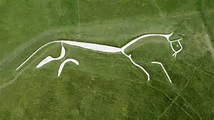HORSES
CATEGORY: ENGLAND
PHOTO: UFFINGTON WHITE HORSE

There was no lodging along The Ridgeway. Every evening I had to walk down from its height to my reserved Bed and Breakfast. This was fortunate; otherwise I would have missed one of the outstanding sights in all of England. On the morning trek back up to the trail from the little hamlet of Woolstone, I looked across the ravine I was ascending and what should I see but the 374 foot long Uffington White Horse leaping across the hillside! I was incredulous! I had seen pictures of it once long ago, but I’d had no idea where it was, nor did I know anything about it.
England has several famous oversized white horses cut through the turf into the white chalk below and then filled with white chalk gravel (this is the same chalk that forms the White Cliffs of Dover), but non of them can compare to the Bronze Age megalith near Uffington. It is the oldest of all of them, but it looks the most modern. It is only a few abstract lines, but it completely captures the graceful movement of a running horse: that is, except for its head. This horse’s head looked like it was attached to its neck with a hinge at its bottom corner. It had lines that might have been called ears, but its mouth was a duck’s beak.
Another thing I didn’t know about The Ridgeway was that it traversed a part of England where there were many race tracks and horse training stables. Every morning the “lads” would bring the horses up to The Ridgeway to exercise them. It was always a treat to step aside and let some of the country’s most magnificent horses pass on their morning gallop, especially after seeing the Uffington horse cut into the hillside! It was like some kind of omen! One would almost think it was a time warp: that the fastest and most beautiful of today’s race horses had been captured and preserved forever in chalk five thousand years ago.
